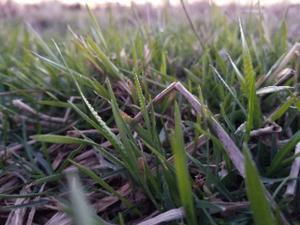Indiana Grazing Bites - December 2023
Victor Shelton is a retired Agronomist/Grazing Specialist with the Natural Resources Conservation Service (NRCS). He continues to write Grazing Bites in his spare time from his property in southwest Indiana.

Henry David Thoreau wrote in his book Walden, “If one advances confidently in the direction of his dreams, and endeavors to live the life which he has imagined, he will meet with a success unexpected in common hours.”
It is the time of year that I like to, at least momentary, reflect back on the year. What did we accomplish, what is better, and what could we have done differently? It was a challenging year, but we made it through and none of us are the worse for wear thus far. The winter feed supply could still possibly be a concern depending on the serverity of weather to come and its duration. Extra hay is always a good insurance policy.
Reflecting back, the big questions for myself are always; Are the livestock, forages and soil all getting better? Could things be more efficient? Did we spend money wisely?
Every year has its own challenges. About the time you think that you have everything figured out for your operation, surprise, something unexpected comes along. Most things can be worked around or adjusted as long as you keep your eye on the forages and manage accordingly. I am reminded occasionally to keep it simple. How exactly do we keep it simple? Follow a few simple rules that I’ve listed before – no matter the time of year.
- Keep the soil covered with live plants – by doing so, erosion will be kept in check and the soil will be cooler, which is better for most forages and for reduced evaporation. You don’t want to see any bare soil. Bare spots allow for increased evaporation, warmer than ideal soil conditions and space for opportunist weeds.
- Maintain a good solar panel – which means, it takes grass to grow grass. We have to try and keep enough green plant leaves for photosynthesis, converting light energy into chemical energy. If the plants have been eaten down too much, energy for new growth is forced to come from stored energy in the roots if available, which is usually slower than photosynthesis. Like you have heard me mention lots of times – don’t graze or rather don’t let the livestock graze closer than four inches for most cool season grasses and not closer than six to eight inches for most warm season grasses. That is the shortest forages left, not the tallest. If you are leaving at least four inches, there will be quite a bit of forage left that is actually taller.
- Provide adequate rest before grazing again. Everything needs rest, including forages. By maintaining good residual heights, or stop grazing heights, regrowth is generally quicker especially with adequate moisture. The plant needs enough time to regrow and express itself again before the next grazing event. Multiple removals during a short time frame or continual removal weakens the plant and actually reduces production. It also reduces new root growth and lowers drought tolerance. So, grow it, graze it, then rest it - it is that simple.
We want the forage to be growing and producing abundantly during the growing season, and as much as possible in a stage and quality that is best for the ruminant livestock grazing it. The livestock know what forage is noteworthy and will seek it out first. If it is the quality they need, they will eat it readily and without hesitation – definitely a desirable species in the eyes of the consumer. When we let these same forages mature too much, which does happen, then forage quality is reduced along with intake. A small amount of the sward reaching maturity isn’t that bad. It can help to build deeper roots, increase soil organic matter from increased amounts and turnover of roots, and help bring up nutrients and water from deeper in the soil profile. This is especially valuable to soils that could use some additional organic matter.
Keeping the soil covered during the winter months is also important. This helps to reduce erosion, increase infiltration and, if enough is allowed to remain, a good place to start grazing the next spring.
Fall and early winter grazing should be approached with care. Grazing before the plants are dormant utilizes reserves that will be needed next spring. Quite a bit of the Midwest was under droughty conditions this fall and a lot of forages responded to this by going dorment a little early. Unfortunately, that also meant less forage to stockpile in many cases. Grazing crop residue, annuals, or the last hay regrowth within reasonable amounts, helps to delay that need to get back on perennial pastures. Earlier grazing, prior to dormancy, is advantageous if you are planning on frost-seeding clover by reducing its competition in the spring.
Lastly, when possible, graze the paddock in a manner that will leave nutrients in place and replace as needed. Smaller allocations tend to have less nutrient transfer than the grazing of large pastures. This is especially true when there is a long walking distance to water, mineral and/or shade. Isolated areas without one or more of the mentioned will be grazed for a shorter period and the ruminating and resting periods afterwards rarely occur unless forced to. This process therefore slowly moves nutrients from one spot to another as manure is more likely to be deposited on the more frequently used areas. Enough with that for now, grow it, graze it, rest it. Maintain cover, don’t over graze it andlet it grow back before grazing it again.
I’d like to hear from you. What do you find challenging about grazing management? Email me at grazingbites@gmail.com. Remember, it’s not about maximizing a grazing event, but maximizing a grazing season! Keep on grazing and Merry Christmas!

